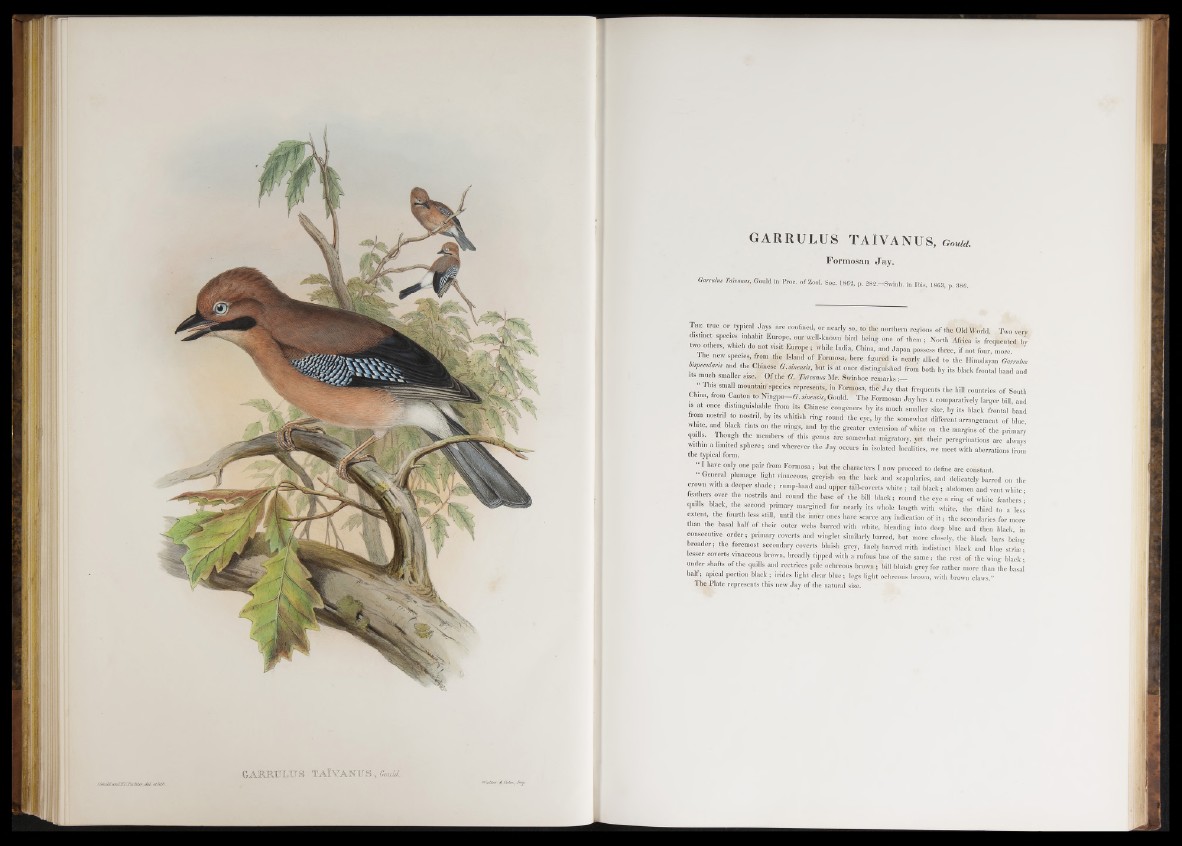
GtABB.17I.TTS TATVANUS,. G ovlcL.
GARRULUS TAIYANUS, Gould.
Formosan J a y .
Garmlm Tdivrnvs, Gould in Proc. o f Zool. Soc. 1862, p. m-Swinh. in Ibis, 1863, p. 386.
I HE true o r typical Jays are confined, or nearly so, t o the northern regions of tile Old World Two verv
distinct species inhabit Enrope, onr well-known' bird being one of them ; North Africa is frequented by
two others, which do not visit Enrope; while India, China, and Japan possess three, if not four, more.'
The new species, from the Island o f Formosa, here figured is nearly allied to the Himalayan Garmhs
mpeculam and the Chinese G. sinensis, but is at once distinguished from both by its black frontal band and
its much smaller size< Of the G. Taivanus Mr. Swinhoe remarks:__
H B h H S B N m I represents, in Formosa, t i f Jay that frequents the hill countries o f South
China, from Canton 1» Nmgpo— G. sinensis, Gould. The Formosan Jay has a comparatively larger bill and
is at once distinguishable from its Chinese congeners by its much smaller size, by its black frontal band
from nostril1 to nostril, by its whitish ring round the eye, by the somewhat different arrangement of blue
white, and black tints o j the wings, and by the greater extension of white on the margins of the primary
E 9 B ? 0Ugh *he members o f tbis *eras " * somewhat migratory, yet their peregrinations are always
within a limited sphere; and wherever the Ja y occurs in isolated localities, we meet with aberrations from
the typical form.
“ I have only one pair from Formosa; but the characters I now proceed to define are constant.
“ General plumage light vinaceous, greyish on the back and scapularies, and delicately barred on the
crown with a deeper shade; rump-hand and upper tlil-coverts wh ite ; tail black; abdomen and vent white •
feathers over the nostrils and round the base of the bill black; round the eye a ring of white feathers •
quills black, the second primary margined for nearly its whole length with white, the third to a less
extent the fourth less still, until the inner ones have scarce any indication of i t; the secondaries for more
than the basal half of their outer webs barred with white, blending into deep blue and then black in
consecutive o rd er; primary coverts and winglet similarly barred, but more closely, the black bars bring
broader; the foremost secondary coverts bluish grey, finely barred with indistinct black and blue strim
lesser coverts vinaceous brown, broadly tipped with a rufous hue o f the same; the rest o f the wing black •
under shafts of the quills and rectrices pale ochreous brown; hill bluish grey for rather more than the basal
half; apical portion black ; irides light clear blue; legs light ochreous brown, with brown claws.”
The Plate represents this new Jay of the natural size.